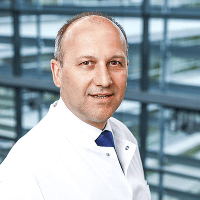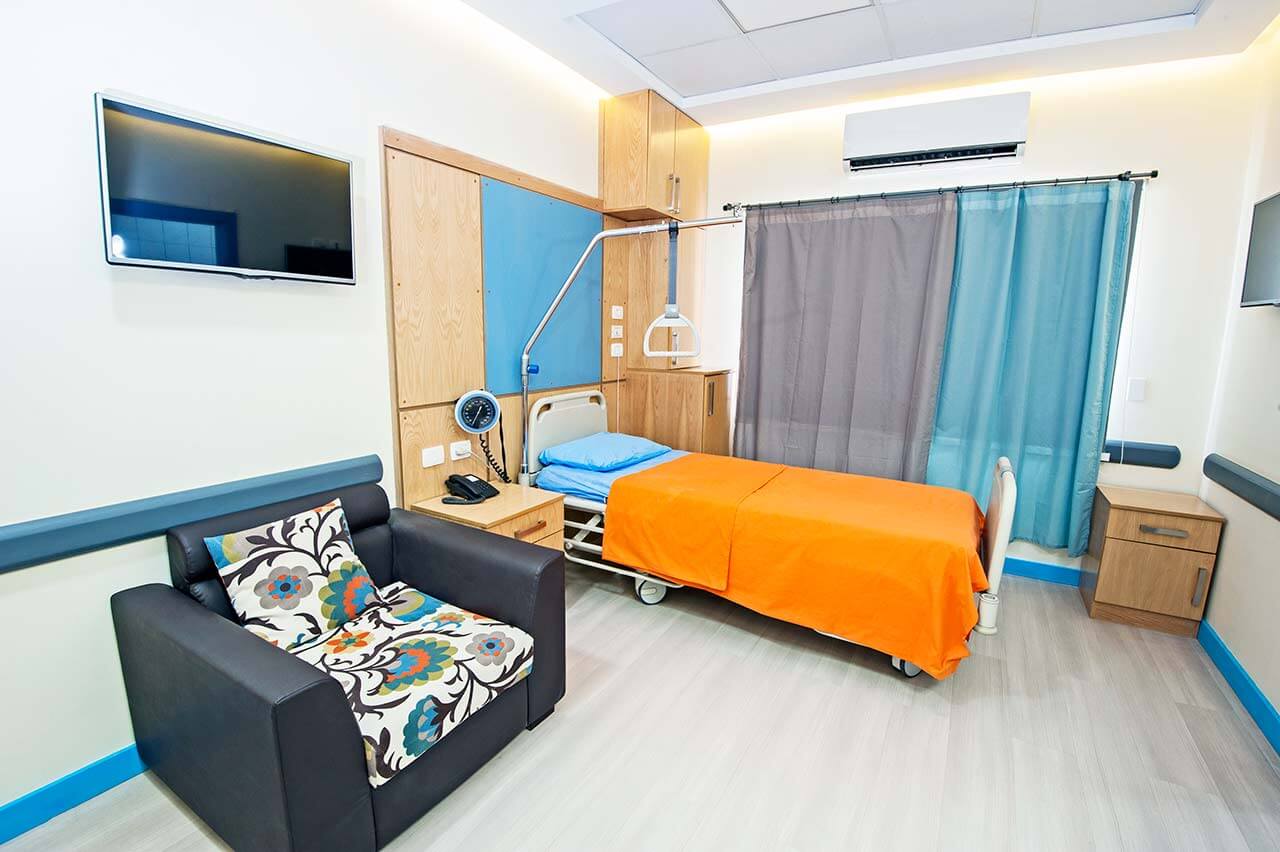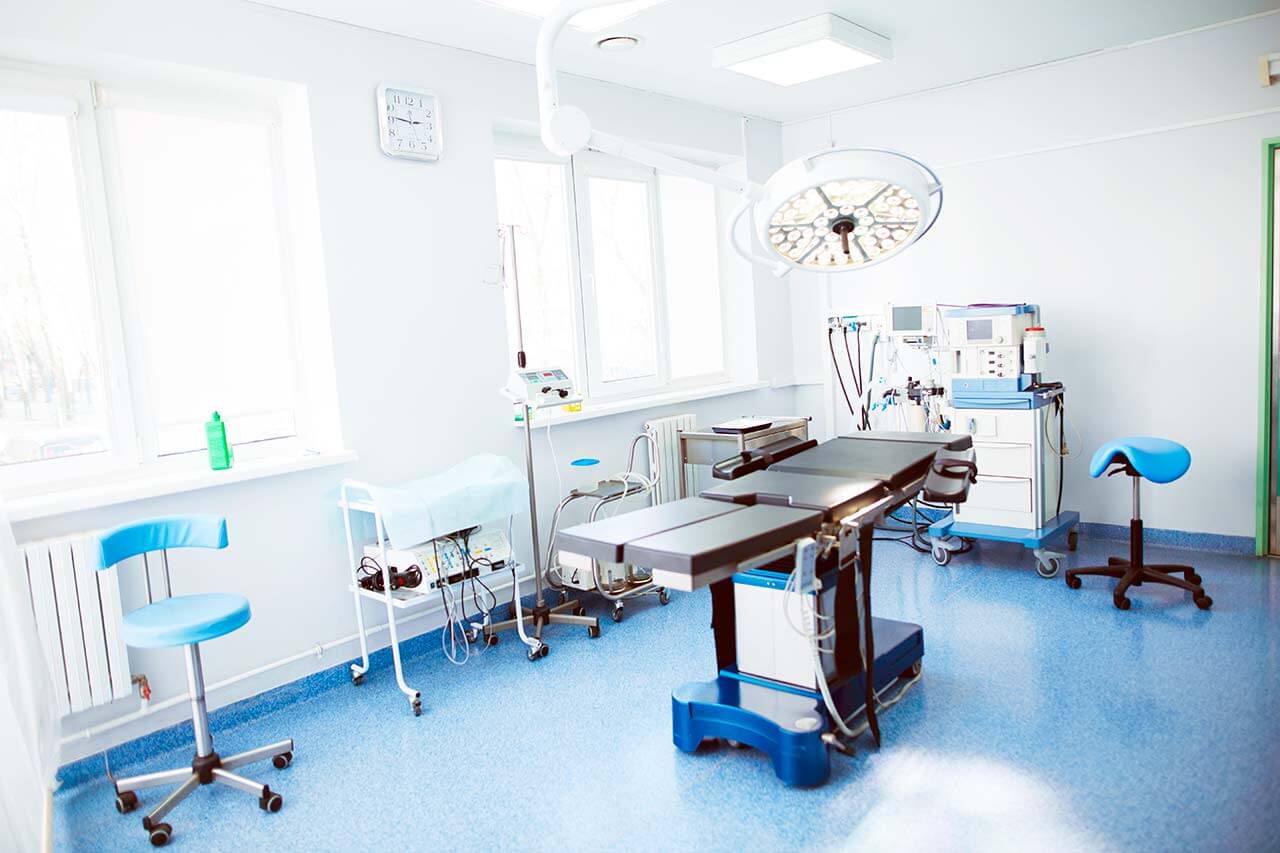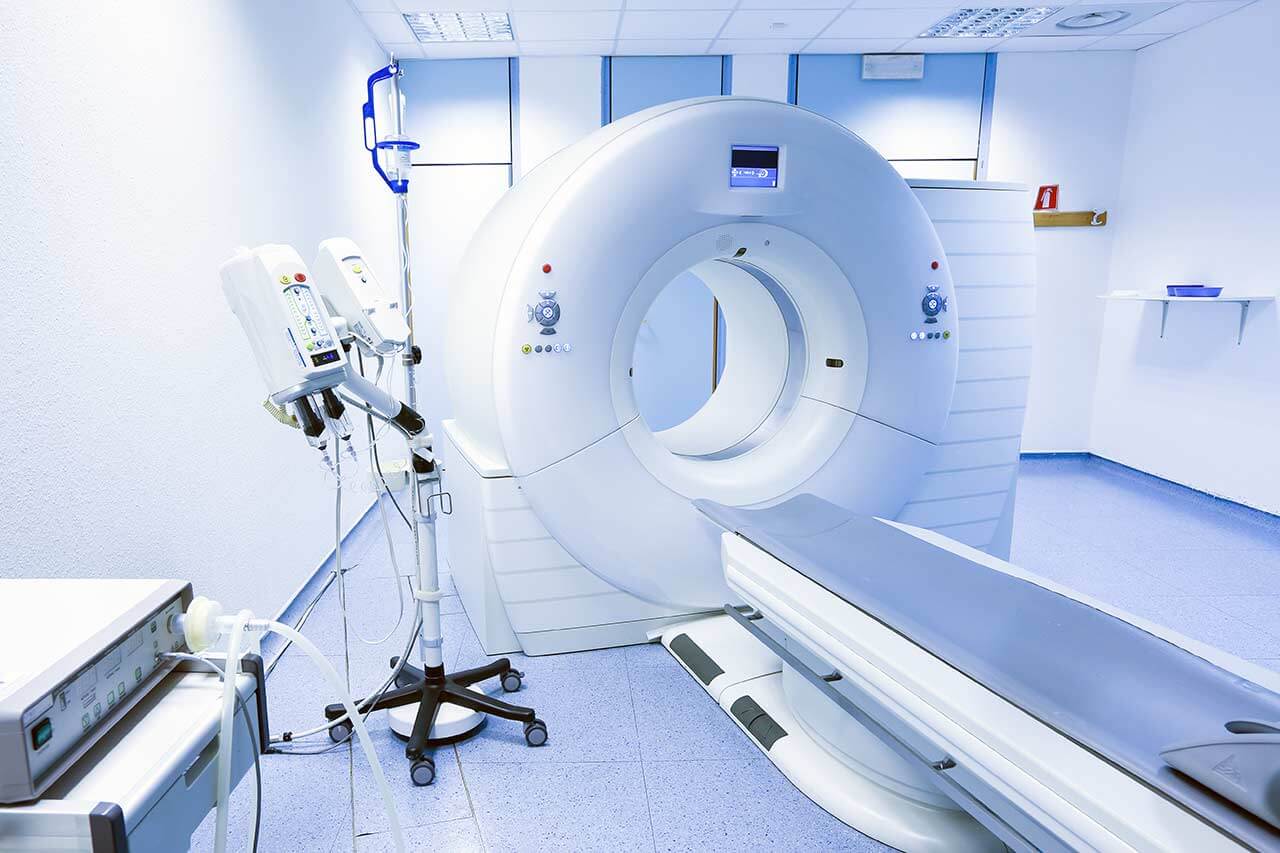
The program includes:
- Initial presentation in the clinic
- clinical history taking
- physical examination
- review of medical records
- laboratory tests:
- complete blood count
- general urine analysis
- biochemical analysis of blood
- indicators of inflammation (CRP, ESR)
- indicators blood coagulation
- x-ray examination of the hip
- MRI scan of the hip
- preoperative care
- hip replacement (hip endoprosthesis)
- symptomatic treatment
- control examinations
- physiotherapeutic procedures
- orthopedic appliances
- the cost of essential medicines and materials
- nursing services
- full hospital accommodation
- explanation of future recommendations
The program includes orthopedic rehabilitation:
- Primary presentation in the clinic
- medical history, including family history
- complex neurological and orthopedic examinations
- X-ray examination
- complex neurophysiological examinations
- individual rehabilitation program, which includes:
- Wii Fit training in the use of the balance
- neuropsychological therapy
- functional therapy of the upper extremities (ArmeoSpring)
- kinesitherapy (physiotherapy)
- biocontrol with feedback
- healing deep muscle massage
- acupuncture of spasticity and pain syndromes
- occupational therapy
- psycho-educational classes
- Individual physiotherapy
- microcurrent treatment
- fangotherapy / cryotherapy
- antispasmodic drug therapy
- mobilization of limb joints
- hydrotherapy / massage therapy / reflexology
- training on special trainers
- and etc.
- nurses care
- stay in the hospital with full board
- symptomatic and drug therapy
How program is carried out
Preliminary preparation for hip replacement includes quitting smoking and drinking alcohol; cancelling non-steroidal anti-inflammatory drugs (diclofenac, ibuprofen); cancelling anticoagulants (warfarin); normalization of body mass, if possible.
Preoperative examination, including consultation with an anesthesiologist and necessary related specialists, takes 1-2 days. According to its results, the most suitable endoprosthesis is selected.
Hip replacement. The operation is performed under general anesthesia. The patient lies on his side, the affected leg is bent and fixed in this position. The surgeon makes an incision 15-20 cm long, minimally traumatizing the muscles and nerve endings. Through this incision, miniature instruments are inserted to remove the damaged joint structures. Healthy bone is adjusted for further reliable implant fixation.
The surgeon installs a femoral stem in the center of the upper part of the femur. Ball-shaped head of the joint is fixed on it. The surgeon also implants a special liner that facilitates movement of the leg and protects the structures of the prosthesis. After the primary fixation of the prosthesis components, the doctor assesses the joint range of motion, as well as the length and symmetry of the lower limb.
The implant is fixed with cement or cementless method. The doctor treats the operating field with antiseptics, conducts its final revision and sutures the wound layer by layer. A temporary drainage is installed in the joint, and a bandage is applied on top.
Postoperative care. During the first day after the intervention the patient stays in the intensive care unit, under round-the-clock medical supervision. After that, with a smooth course of the postoperative period, the patient is transferred to a regular ward and the drains are removed. The range of motion expands gradually, from light toes movements to walking. Walking with the use of walking aids is allowed in 3-5 days after the operation.
Rehabilitation. The rehabilitation program begins after the transfer of the patient from the intensive care unit to a regular ward. It includes physical activity (from exercises in bed in the early days to exercises in the gym), physiotherapy, massage (including lymphatic drainage), exercises in the water. The rehabilitation program is constantly being adjusted according to the needs of the patient.
Required documents
- X-ray examination of the hip joints
- MRI scan of the hip joints, if available
Service
You may also book:
 BookingHealth Price from:
BookingHealth Price from:
About the department
The Department of Adult and Pediatric Traumatology, Orthopedic Surgery, Hand and Foot Surgery at the Municipal Hospital Karlsruhe offers the full range of modern services to the patients with musculoskeletal diseases and injuries. The key areas of specialization include conservative and surgical treatment of injuries and degenerative changes in the limbs, joints, pelvis and spine. The department is certified by the German Trauma Society (DGU) and has an SAV certificate, which indicates the excellent achievements of the medical facility in the treatment of injuries of any severity. The department performs most surgical interventions using minimally invasive and endoscopic surgical techniques, thanks to which the patients can regain their mobility and return to their usual daily life in the shortest possible time. The department's experienced surgeons perform more than 6,000 operations annually, including particularly complex ones. About 3,000 inpatients and more than 20,000 outpatients receive medical care here every year. The department has 90 beds. The Head Physician of the department is Prof. Dr. med. Christof Müller.
The department is the leading interregional Trauma Center in North Baden, therefore it has unique experience and the highest qualifications in the treatment of patients with severe and multiple injuries. The Central Emergency Care Unit guarantees multidisciplinary and competent care for the patients with minor and severe injuries. Both adults and children can receive medical care here.
The priority focus of the department's clinical activity is the treatment of diseases of the shoulder, elbow, wrist, hip, knee and ankle joints. For this purpose, arthroscopic surgery is widely used – minimally invasive intra-articular interventions. The department also successfully performs joint replacement surgery. When performing joint replacement surgery, the department's specialists use the very latest and proven surgical implantation techniques, as well as high-quality prostheses from well-known world manufacturers. Computer navigation allows the doctors to perform operations with maximum accuracy, while minimally invasive techniques ensure sparing surgery and a rapid rehabilitation. In addition to the total joint replacement with an artificial prosthesis, the department's surgeons also perform technically complex revision interventions, which are sometimes required during the long-term use of the implanted endoprosthesis and its wear.
The department also performs all modern types of interventions to restore cartilage tissue. Microfracturing and autologous chondrocyte transplantation using special matrices are among the most popular. The interventions are performed arthroscopically, usually under local anesthesia. Both therapeutic techniques help the doctors to effectively eliminate cartilage defects, thereby alleviating pain and ceasing degenerative processes in the joints.
The specialists have more than 10 years of experience in the field of surgical treatment of spinal pathologies. The doctors most often deal with degenerative spinal changes and injuries caused by accidents. With appropriate indications, a sparing thoracoscopic technique is used during the surgical treatment. The range of operations varies from spinal fusion to intervertebral disc replacement in young patients.
The department also includes the Section of Physiotherapy, whose specialists carry out physiotherapy procedures immediately after operations, as well as on an outpatient basis. Such an approach allows the doctors to achieve a rapid mobilization of the patient after the orthopedic surgical procedure.
The department's medical team provides each patient with highly competent medical assistance, pays personal attention and care, and creates the most comfortable conditions for their stay. The specialists strive to find an optimal solution for the patient and provide him with the most sparing treatment.
The department's main clinical focuses include:
- Traumatology
- Treatment of injuries of any severity in adults and children (in the certified Center of the German Trauma Society)
- Orthopedic surgery
- Arthroscopic interventions on the shoulder, elbow, wrist, hip, knee and ankle joints
- Primary and revision knee, hip and shoulder replacement surgery
- Corrective surgery and follow-up interventions after accidents and injuries
- Surgical treatment of spinal diseases
- Spinal fusion
- Intervertebral disc replacement surgery
- Surgical treatment of shoulder diseases
- Treatment of impingement syndromes
- Treatment of calcifying tendinitis
- Treatment of rotator cuff tears
- Treatment of shoulder instability
- Surgical treatment of knee diseases with a focus on the correction of cartilage defects
- Microfracture surgery
- Autologous chondrocyte transplantation using special matrices
- Hand surgery
- Treatment of congenital and acquired hand diseases or injuries in adults and children
- Treatment of Dupuytren's contracture
- Treatment of finger arthrosis
- Treatment of ganglion
- Treatment of carpal tunnel syndrome
- Treatment of fractures and other traumatic injuries
- Treatment of congenital and acquired hand diseases or injuries in adults and children
- Foot surgery
- Treatment of congenital and acquired foot diseases or injuries in adults and children
- Hallux valgus repair
- Hallux rigidus repair
- Treatment of flat feet
- Treatment of ankle dislocations and fractures
- Treatment of heel spurs
- Treatment of congenital and acquired foot diseases or injuries in adults and children
- Other medical services
Photo of the doctor: (c) Städtische Klinikum Karlsruhe
About hospital
The Municipal Hospital Karlsruhe is a modern maximum care medical facility, which combines a long tradition and the advanced achievements of modern medicine. The hospital operates on the basis of the University of Freiburg, so scientific innovations in the field of diagnostics and treatment are continuously introduced into practice here. The hospital presents almost all areas of modern medicine, including many medical services for young patients.
A highly qualified and experienced team of more than 4,500 employees provides impeccable medical care. The medical facility has 1,571 beds for the hospitalization of its patients. The hospital admits more than 63,000 inpatients and about 186,000 outpatients annually. A large number of patients wishing to receive medical care in the hospital speak for themselves and are a confirmation of the exceptional service, as well as the effectiveness of the treatment provided.
The quality management system of the hospital's medical care is certified in accordance with the DIN EN ISO 9001 standards. Since 2016, the hospital has implemented a regular quality control in compliance with the strict standards of the Initiative Quality Medicine (IQM). In addition, almost all departments of the hospital have numerous certificates in their areas of specialization, including certificates from the German Cancer Society (DKG), the German Society for General and Visceral Surgery (DGAV), the German Cardiac Society (DGK), the German Diabetes Society (DDG), the German Society of Nephrology (DGN), the German Trauma Society (DGU), etc.
The main value of the hospital's staff is the health and satisfaction of their patients, so a respect and a humane attitude towards each patient remain priorities. The doctors and nursing staff support each patient in every possible way on their path to recovery. The specialists also strive to perform the most sparing, but at the same time the most effective and safe treatment.
Photo: (с) depositphotos
Accommodation in hospital
Patients rooms
The patients of the Municipal Hospital Karlsruhe live in cozy patient rooms with everything necessary for a comfortable stay. Standard patient room furnishing includes an automatically adjustable bed, a bedside table, a TV, and a telephone. The patient rooms have Wi-Fi. Each patient room also has an ensuite bathroom with a shower and a toilet.
The patient rooms in the pediatric departments are specially designed for children, so that young patients feel at home. Children can live in their patient room with one of their parents. There are also special playrooms designed for children.
Meals and Menus
The patients of the hospital are offered tasty and varied three meals a day: breakfast, lunch and dinner. The menu also features dietary meals. The kitchen staff will gladly accept all the individual wishes of patients.
The hospital also has a cozy cafe where one can have a tasty snack, drink tea, coffee and soft drinks.
Further details
Standard rooms include:
Religion
The hospital has two chapels that regularly host Protestant, Catholic, and Ecumenical worship services. A patient can watch the broadcast of the worship on TV channels in his own room, if desired.
Accompanying person
Your accompanying person may stay with you in your patient room or at the hotel of your choice during the inpatient program.
Hotel
You may stay at the hotel of your choice during the outpatient program. Our managers will support you for selecting the best option.





